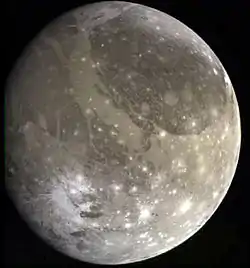
Ganymede is a moon of Jupiter and the largest moon in the Solar System. Completing an orbit in roughly seven days, it is the seventh moon and third Galilean moon from Jupiter. Ganymede participates in a 1:2:4 orbital resonance with the moons Europa and Io, respectively. It is larger in diameter than the planet Mercury but has only about half its mass. It has the highest mass of all planetary satellites with 2.01 times the mass of the Earth's moon. It is composed primarily of silicate rock and water ice, and a saltwater ocean is believed to exist nearly 200 km below Ganymede's surface. Ganymede is the only satellite in the Solar System known to possess a magnetosphere, likely created through convection within the liquid iron core. The satellite has a thin oxygen atmosphere that includes O, O2, and possibly O3. Ganymede's discovery is credited to Galileo Galilei, who observed it in 1610. The satellite's name was soon suggested by astronomer Simon Marius, for the mythological Ganymede, cupbearer of the Greek gods and Zeus's beloved. (Full article...)